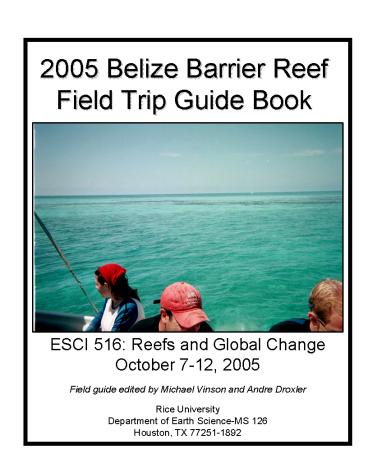2005 Belize Barrier Reef Field Trip Guide Book - PowerPoint PPT Presentation
1 / 39
Title: 2005 Belize Barrier Reef Field Trip Guide Book
1
2005 Belize Barrier Reef Field Trip Guide Book
ESCI 516 Reefs and Global Change October 7-12,
2005 Field guide edited by Michael Vinson and
Andre Droxler Rice University Department of
Earth Science-MS 126 Houston, TX 77251-1892
2
(No Transcript)
3
(No Transcript)
4
(No Transcript)
5
(No Transcript)
6
(No Transcript)
7
(No Transcript)
8
(No Transcript)
9
Mangrove Swamps and Submerged Peat Blocks of the
Belize Barrier Reef System Twin Cay and Tobacco
RangeMicah Nicolo and Michael Vinson
1. Introduction The roots gave off clicking
sounds, and the odor was disgusting. We felt
like we were watching something horrible. That
is how John Steinbeck and Ed Ricketts depicted
the mangroves in 1941 in the Sea of Cortez.
Mangrove communities dominate the worlds
tropical and subtropical coasts paralleling the
geographic distribution of coral reefs. Like
reefs, mangrove swamps are environments formed by
organisms, but unlike most coral communities,
mangroves thrive in the intertidal zone and
endure a wide range of salinities (Rutzler
Feller, 1988). Soil reduction and sulfide
accumulation also help to determine the
distribution and growth of mangroves (McKee et
al., 1988). The general health of mangrove
communities is affected by stresses caused by
hurricanes, environmental disturbances (i.e.,
desiccation during low tides), and human
damage. 1.1 Mangrove Communities--Mangrove
refers to an assemblage of plants from five
families with common ecological, morphological,
and physiological characteristics that allow them
to live in tidal swamps. Worldwide, at least 34
species in nine genera are considered to be true
mangroves (Rutzler Feller, 1988). P.B.
Tomlinson (1986) defines these mangroves by five
features (1) they are ecologically restricted to
tidal swamps, (2) the major element of the
community frequently forms pure sands, (3) the
plants are morphologically adapted with aerial
roots and viviparity (producing new plants
instead of seeds), (4) they are physiologically
adapted for salt exclusion or salt excretion, and
(5) they are taxonomically isolated from
terrestrial relatives, at least at the generic
level. Three major mangrove species of dominate
the mangrove swamps of the Belize Barrier Reef
system (McKee et al., 1988). These three types
are defined in part by their morphology and
habitat. The first type, Rhizophora mangle (red
mangrove), is found in the regularly flooded
intertidal zone. R. mangle is characterized by
its roots, which may be prop (descend from the
lower part of the stem) or drop (descend from
branches and the upper part of the stem) (Figure
1) (Gill Tomlinson, 1977). Avicennia germinans
(black mangrove) inhabit the area a little
further up the shoreline, where the water is
shallower. A. germinans is characterized by its
horizontal (cable) roots which extend from the
trunk base and radiate outward for several meters
just below the surface (Figure 1) (Gill
Tomlinson, 1977). Negatively geotropic roots
called pneumatophores, which are covered with
lenticels are produced from the horizontal roots
(Figure 1). These two mangrove types generally
live in distinct zones in the community, with
slight intermixing. The third type, Laguncularia
racemosa (white mangrove), generally inhabits the
highest elevations in the interior of the
mangrove community in scattered stands among A.
germinans and R. mangle (McKee et al.,
1988). 1.2 Regional Considerations--Twin Cays
and Tobacco Range are two typical mangrove swamp
communities, which exist within the Belize
Barrier Reef system. These communities lie to
the west of the reef barrier crest (Figure 2).
Twin Cays
10
(No Transcript)
11
(No Transcript)
12
(No Transcript)
13
(No Transcript)
14
(No Transcript)
15
(No Transcript)
16
(No Transcript)
17
(No Transcript)
18
(No Transcript)
19
Glovers AtollJulie Maher and Shayda Naficy
1. Introduction Glovers Atoll encompasses an
area of approximately 260 km2. It is composed of
isolated carbonate platform breakwater reefs,
encircling a lagoon (up to18 m deep). There
exists N-S flowing countercurrents w/in lagoon.
The area of Glovers Atoll is comprised of 860
patch reefs that are fed through open
circulation, with water temperatures in the range
of 23-31oC and a salinity that ranges between
38.6-42.0. The sedimentation rate in and around
these patch reefs is approximately 0.46 m/ky
(Gischler, 2003).
Dive Stops Reef Front/Fore-Reef Lagoon Patch
Reefs Southwestern Edge
20
(No Transcript)
21
(No Transcript)
22
(No Transcript)
23
(No Transcript)
24
(No Transcript)
25
(No Transcript)
26
The Rhomboid Reefs of South Central BelizeCatie
Cardwell and Kristy Milliken
1. Introduction Rhomboid reefs in South Central
Belize comprise a type of lagoonal patch reef.
Other than the plan view rhomboid shape, these
reefs have little to distinguish them from
traditional patch reefs. Two dominant hypotheses
for reef development in a rhomboid shape have
emerged. Purdy (1974, 2003) asserts that
Pleistocene fault block formation and subsequent
reef establishment on the rhomboidal shaped fault
blocks accounts for reef shape. Shinn et al.
(1979) proposed an alternative model in which
lagoonal rhomboid reefs are late Pleistocene and
Holocene buildups constructed on siliciclastic
fluvial levees. Additional work by Halley et al.
(1977), Choi and Ginsberg (1982) Westphall
(1986), and Ferro et al. (1999) all support the
Shinn model.
CHANNEL CAYE REEF COMPLEX Dive Stop
27
(No Transcript)
28
(No Transcript)
29
(No Transcript)
30
(No Transcript)
31
(No Transcript)
32
Siliciclastic Sedimentation of Coastal
BelizeJason Francis and Clayton Forswall
Figure 1. Location Map of Maya Mountains and
general lithology types, Belize. This figure
also contains bathymetry contours across the
lagoon and within the atolls. Figure from Purdy
Gischler, 2003.
33
(No Transcript)
34
(No Transcript)
35
(No Transcript)
36
(No Transcript)
37
(No Transcript)
38
(No Transcript)
39
(No Transcript)































